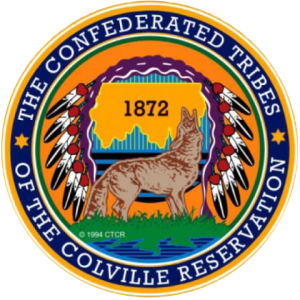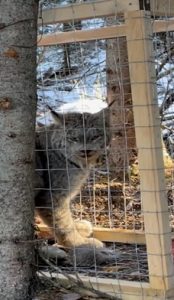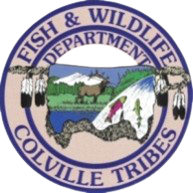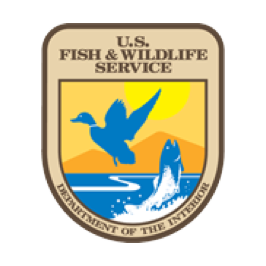Colville Tribes Works with Group Leaders to Relocate Lynx from Canada
 NEWS RELEASE – November 10, 2021
NEWS RELEASE – November 10, 2021
Colville Tribes Fish & Wildlife PO Box 150 Nespelem, WA 99155
Phone: (509) 634-2110 Fax: (509) 634-2126
 Nespelem, WA – In the past few weeks, several lynx (wápupxn) have been captured in Canada and relocated to the Colville Indian Reservation in Washington state in hopes that a resilient population will be established there.
Nespelem, WA – In the past few weeks, several lynx (wápupxn) have been captured in Canada and relocated to the Colville Indian Reservation in Washington state in hopes that a resilient population will be established there.
Project biologists, trappers and veterinarians are working together to ensure that the safest techniques are being used during processing and transportation of these animals.
Richard Whitney, wildlife manager for Colville Tribes’ Fish and Wildlife (CTFW) discusses what it takes to capture and process these native, forest carnivores.

“The lynx are live trapped using box style traps that are baited with an assortment of attractants,” says Whitney. “We are working in partnership with existing trappers on established trap lines. In fact, they do the trapping for us and we are able to take the cats out live without them harvesting the lynx for pelts. We pay them a set rate for the cats, so that they don’t lose money for each lynx that they don’t sell to the fur market. They have been great partners in this project. We currently have two trap lines that are being monitored.”
In Canada, the lynx are not a listed species so it is legal to trap them. But in Washington state, Canada lynx are listed as a federally threatened species so multiple permits were required to handle and transport these animals, including species that are protected by the Convention on International Trade in Endangered Species of Wild Fauna and Flora or (CITES) treaty, which ensures that international trade in plants and animals does not threaten their survival in the wild.
“If we catch a lynx, we chemically immobilize it and then we take all the predetermined measurements, samples, vital signs, body condition, and apply a GPS collar,” said Whitney. “Once they are processed, we put the lynx in the transport container and administer the reversal drugs to wake the lynx up and we continue to monitor their health. We have a B.C. veterinarian inspect the lynx, feed them for the night, and leave the area until the following morning when the lynx is then transported to the border.” He said, “At the border, the lynx are transferred to the U.S. lynx release team and are transported to the release location on the reservation. The lynx are usually released just over 24 hours from removal from the trap.”
 “The Colville Tribes, in critical partnerships with Conservation Northwest, Upper Columbia United Tribes (UCUT), and others, are leading the restoration efforts for Canada lynx in the Kettle Mountain Range,” said Whitney. “It is our goal to establish a healthy, self-sustaining population of lynx that can help to restore balance to a landscape that has not seen a robust population in decades. This has been a large team effort of tribal wildlife staff led by Rose Piccinini, Conservation Northwest, UCUT, the B.C. trappers and numerous others, including volunteers from other state agencies that helped along the way.”
“The Colville Tribes, in critical partnerships with Conservation Northwest, Upper Columbia United Tribes (UCUT), and others, are leading the restoration efforts for Canada lynx in the Kettle Mountain Range,” said Whitney. “It is our goal to establish a healthy, self-sustaining population of lynx that can help to restore balance to a landscape that has not seen a robust population in decades. This has been a large team effort of tribal wildlife staff led by Rose Piccinini, Conservation Northwest, UCUT, the B.C. trappers and numerous others, including volunteers from other state agencies that helped along the way.”
Rose Piccinini, wildlife biologist for CTFW said, “In the last 10 years, there have been detections of lynx in Kettle that suggest they are present but likely not part of a resident breeding population. By reestablishing a breeding population in the Kettle Range, we would be connecting lynx populations from the Cascades to the Canadian Rockies.”
CTFW has received support and funding from the Bureau of Indian Affairs’ Endangered Species Program, the U.S. Fish and Wildlife Service’s Tribal Wildlife Grant, Conservation Northwest, and others.
“We have a long history with lynx conservation in Washington,” said Dave Werntz, science and conservation director for Conservation Northwest. “And given the extensive habitat loss from fire in the Okanogan region, we began to look toward restoring lynx to the Kettle Range for regional benefits. We commissioned a scientific analysis which showed the Kettle Range has excellent habitat that would support lynx, and shared it with the Tribes’ Fish and Wildlife staff and other partners. When the lynx translocation project was launched, we looked for ways to help as much as possible including with lynx capture, trapper coordination, and other operations in British Columbia.”
The goal of the project is to relocate at least 50 Canada lynx to the reservation which could take up to five years to complete.
 Contact: Michelle Campobasso
Contact: Michelle Campobasso
Colville Tribes Fish and Wildlife
Public Relations Specialist
(509) 634-2106






